The Rise of Domestic Violence Cases During the COVID-19 Pandemic
VerifiedAdded on 2021/09/18
|19
|6271
|145
Essay
AI Summary
This essay examines the significant increase in domestic violence cases during the COVID-19 pandemic. It explores various forms of abuse, including physical, mental, emotional, and economic, and their impact on individuals and society. The essay highlights the contributing factors to this surge, such as lockdowns, financial instability, and increased stress. It provides a global perspective, comparing data from different countries, including India, and discusses the specific challenges faced by women and men. The essay also delves into the reasons behind the rise in domestic violence, including economic uncertainty and the lack of support systems. Furthermore, it explores measures and interventions to combat domestic violence, including government programs, community-level responses, and international efforts. The essay emphasizes the need for awareness, zero tolerance, and support for victims of domestic violence during and after the pandemic.
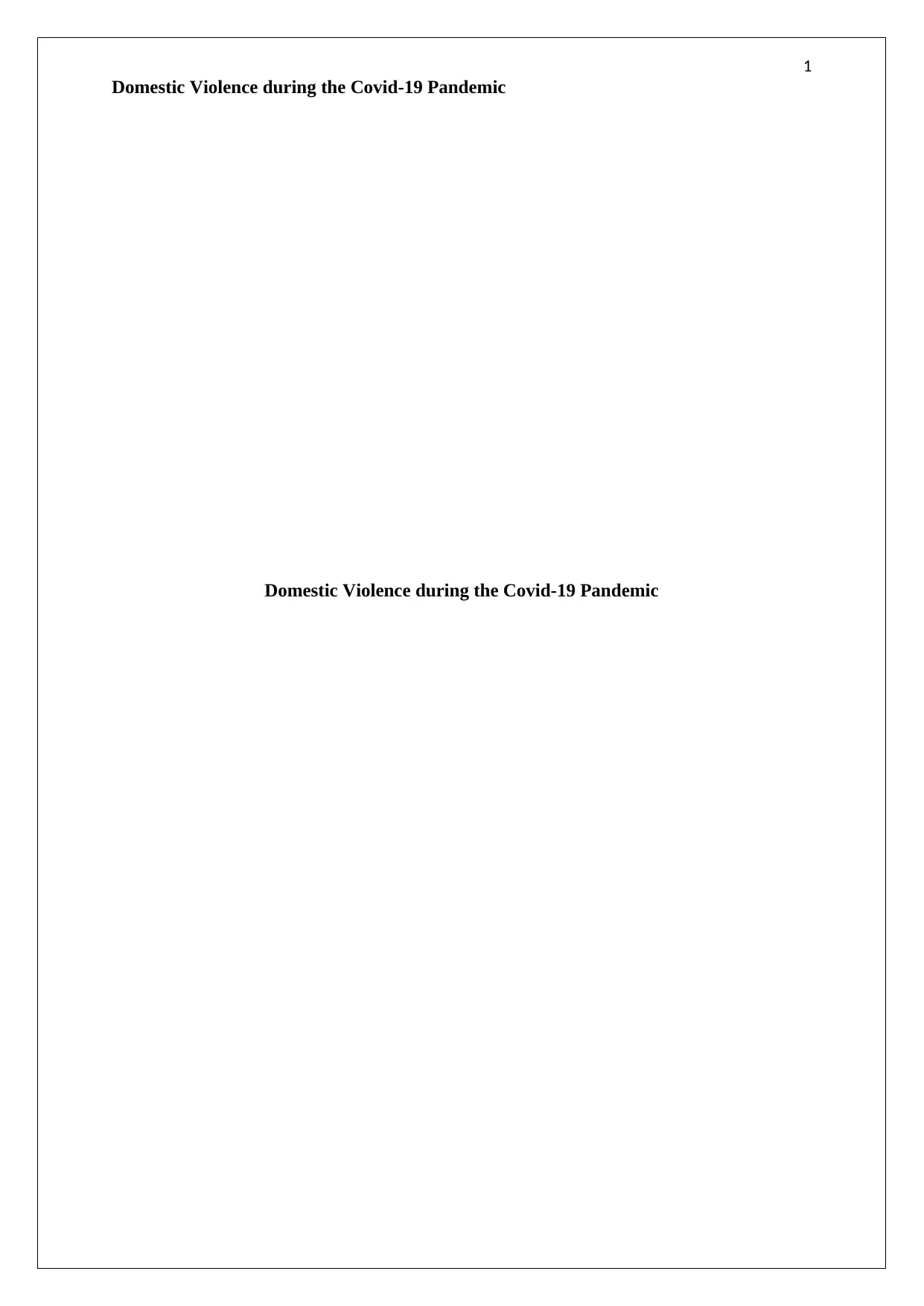
1
Domestic Violence during the Covid-19 Pandemic
Domestic Violence during the Covid-19 Pandemic
Domestic Violence during the Covid-19 Pandemic
Domestic Violence during the Covid-19 Pandemic
Paraphrase This Document
Need a fresh take? Get an instant paraphrase of this document with our AI Paraphraser
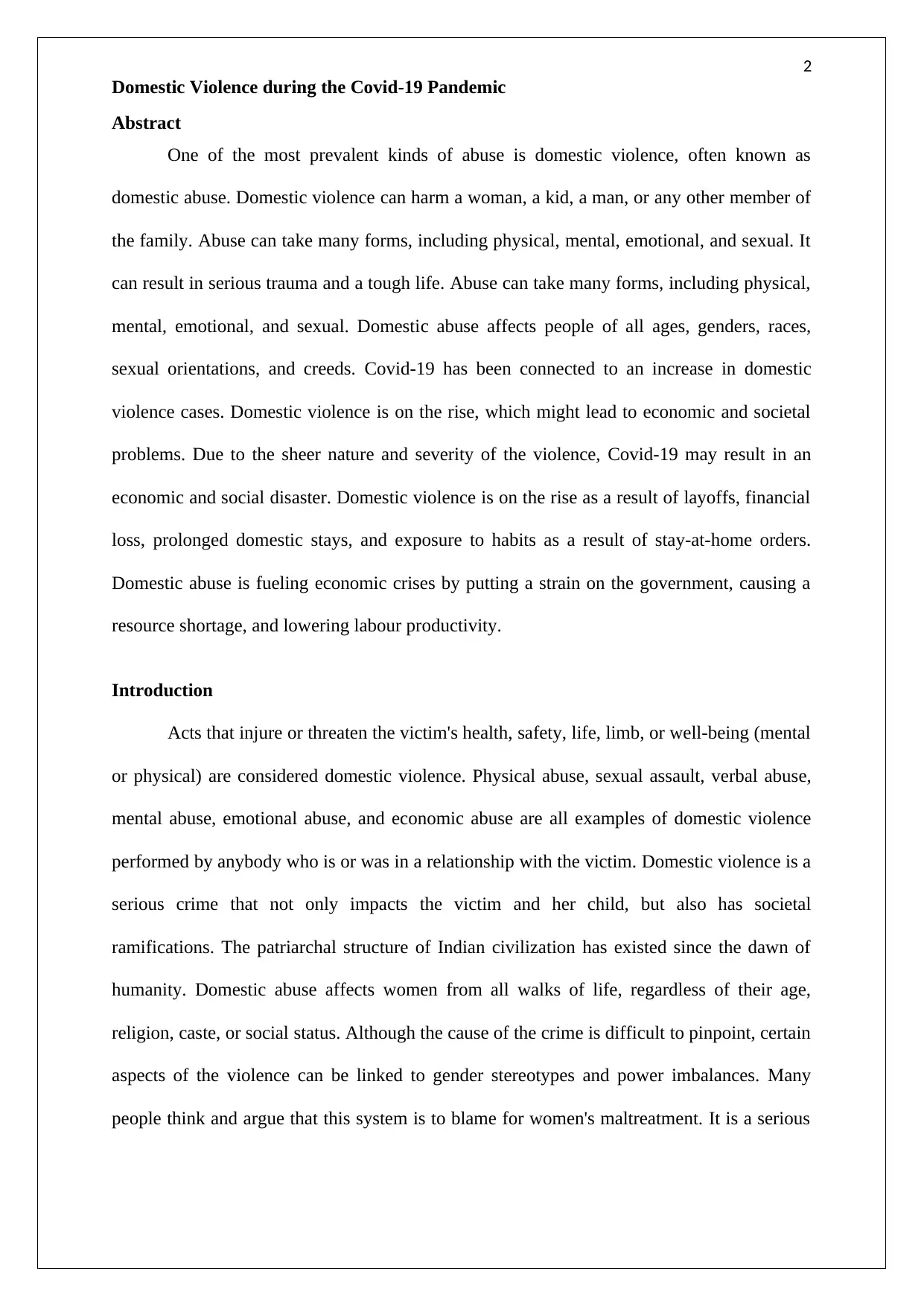
2
Domestic Violence during the Covid-19 Pandemic
Abstract
One of the most prevalent kinds of abuse is domestic violence, often known as
domestic abuse. Domestic violence can harm a woman, a kid, a man, or any other member of
the family. Abuse can take many forms, including physical, mental, emotional, and sexual. It
can result in serious trauma and a tough life. Abuse can take many forms, including physical,
mental, emotional, and sexual. Domestic abuse affects people of all ages, genders, races,
sexual orientations, and creeds. Covid-19 has been connected to an increase in domestic
violence cases. Domestic violence is on the rise, which might lead to economic and societal
problems. Due to the sheer nature and severity of the violence, Covid-19 may result in an
economic and social disaster. Domestic violence is on the rise as a result of layoffs, financial
loss, prolonged domestic stays, and exposure to habits as a result of stay-at-home orders.
Domestic abuse is fueling economic crises by putting a strain on the government, causing a
resource shortage, and lowering labour productivity.
Introduction
Acts that injure or threaten the victim's health, safety, life, limb, or well-being (mental
or physical) are considered domestic violence. Physical abuse, sexual assault, verbal abuse,
mental abuse, emotional abuse, and economic abuse are all examples of domestic violence
performed by anybody who is or was in a relationship with the victim. Domestic violence is a
serious crime that not only impacts the victim and her child, but also has societal
ramifications. The patriarchal structure of Indian civilization has existed since the dawn of
humanity. Domestic abuse affects women from all walks of life, regardless of their age,
religion, caste, or social status. Although the cause of the crime is difficult to pinpoint, certain
aspects of the violence can be linked to gender stereotypes and power imbalances. Many
people think and argue that this system is to blame for women's maltreatment. It is a serious
Domestic Violence during the Covid-19 Pandemic
Abstract
One of the most prevalent kinds of abuse is domestic violence, often known as
domestic abuse. Domestic violence can harm a woman, a kid, a man, or any other member of
the family. Abuse can take many forms, including physical, mental, emotional, and sexual. It
can result in serious trauma and a tough life. Abuse can take many forms, including physical,
mental, emotional, and sexual. Domestic abuse affects people of all ages, genders, races,
sexual orientations, and creeds. Covid-19 has been connected to an increase in domestic
violence cases. Domestic violence is on the rise, which might lead to economic and societal
problems. Due to the sheer nature and severity of the violence, Covid-19 may result in an
economic and social disaster. Domestic violence is on the rise as a result of layoffs, financial
loss, prolonged domestic stays, and exposure to habits as a result of stay-at-home orders.
Domestic abuse is fueling economic crises by putting a strain on the government, causing a
resource shortage, and lowering labour productivity.
Introduction
Acts that injure or threaten the victim's health, safety, life, limb, or well-being (mental
or physical) are considered domestic violence. Physical abuse, sexual assault, verbal abuse,
mental abuse, emotional abuse, and economic abuse are all examples of domestic violence
performed by anybody who is or was in a relationship with the victim. Domestic violence is a
serious crime that not only impacts the victim and her child, but also has societal
ramifications. The patriarchal structure of Indian civilization has existed since the dawn of
humanity. Domestic abuse affects women from all walks of life, regardless of their age,
religion, caste, or social status. Although the cause of the crime is difficult to pinpoint, certain
aspects of the violence can be linked to gender stereotypes and power imbalances. Many
people think and argue that this system is to blame for women's maltreatment. It is a serious
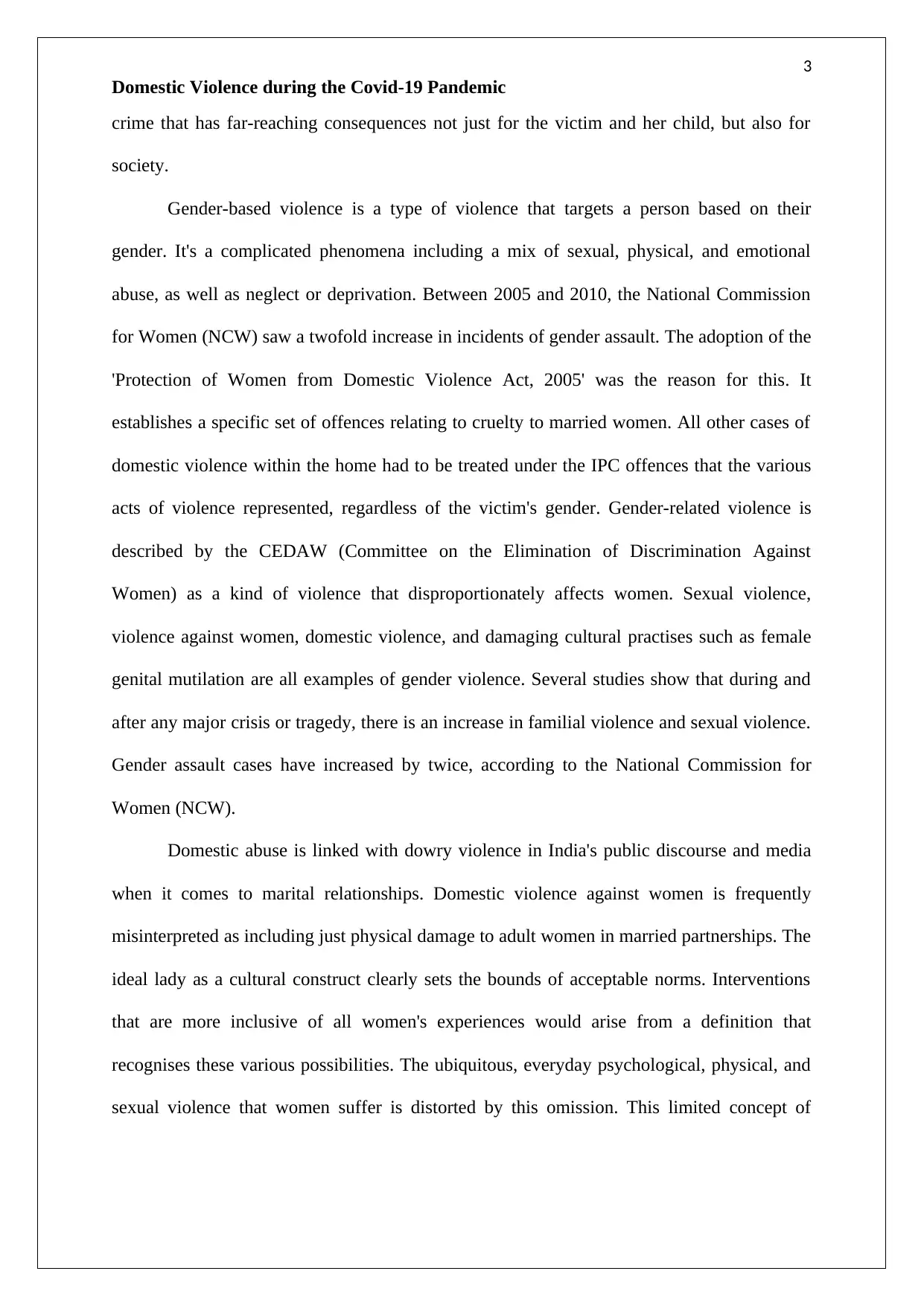
3
Domestic Violence during the Covid-19 Pandemic
crime that has far-reaching consequences not just for the victim and her child, but also for
society.
Gender-based violence is a type of violence that targets a person based on their
gender. It's a complicated phenomena including a mix of sexual, physical, and emotional
abuse, as well as neglect or deprivation. Between 2005 and 2010, the National Commission
for Women (NCW) saw a twofold increase in incidents of gender assault. The adoption of the
'Protection of Women from Domestic Violence Act, 2005' was the reason for this. It
establishes a specific set of offences relating to cruelty to married women. All other cases of
domestic violence within the home had to be treated under the IPC offences that the various
acts of violence represented, regardless of the victim's gender. Gender-related violence is
described by the CEDAW (Committee on the Elimination of Discrimination Against
Women) as a kind of violence that disproportionately affects women. Sexual violence,
violence against women, domestic violence, and damaging cultural practises such as female
genital mutilation are all examples of gender violence. Several studies show that during and
after any major crisis or tragedy, there is an increase in familial violence and sexual violence.
Gender assault cases have increased by twice, according to the National Commission for
Women (NCW).
Domestic abuse is linked with dowry violence in India's public discourse and media
when it comes to marital relationships. Domestic violence against women is frequently
misinterpreted as including just physical damage to adult women in married partnerships. The
ideal lady as a cultural construct clearly sets the bounds of acceptable norms. Interventions
that are more inclusive of all women's experiences would arise from a definition that
recognises these various possibilities. The ubiquitous, everyday psychological, physical, and
sexual violence that women suffer is distorted by this omission. This limited concept of
Domestic Violence during the Covid-19 Pandemic
crime that has far-reaching consequences not just for the victim and her child, but also for
society.
Gender-based violence is a type of violence that targets a person based on their
gender. It's a complicated phenomena including a mix of sexual, physical, and emotional
abuse, as well as neglect or deprivation. Between 2005 and 2010, the National Commission
for Women (NCW) saw a twofold increase in incidents of gender assault. The adoption of the
'Protection of Women from Domestic Violence Act, 2005' was the reason for this. It
establishes a specific set of offences relating to cruelty to married women. All other cases of
domestic violence within the home had to be treated under the IPC offences that the various
acts of violence represented, regardless of the victim's gender. Gender-related violence is
described by the CEDAW (Committee on the Elimination of Discrimination Against
Women) as a kind of violence that disproportionately affects women. Sexual violence,
violence against women, domestic violence, and damaging cultural practises such as female
genital mutilation are all examples of gender violence. Several studies show that during and
after any major crisis or tragedy, there is an increase in familial violence and sexual violence.
Gender assault cases have increased by twice, according to the National Commission for
Women (NCW).
Domestic abuse is linked with dowry violence in India's public discourse and media
when it comes to marital relationships. Domestic violence against women is frequently
misinterpreted as including just physical damage to adult women in married partnerships. The
ideal lady as a cultural construct clearly sets the bounds of acceptable norms. Interventions
that are more inclusive of all women's experiences would arise from a definition that
recognises these various possibilities. The ubiquitous, everyday psychological, physical, and
sexual violence that women suffer is distorted by this omission. This limited concept of
⊘ This is a preview!⊘
Do you want full access?
Subscribe today to unlock all pages.

Trusted by 1+ million students worldwide
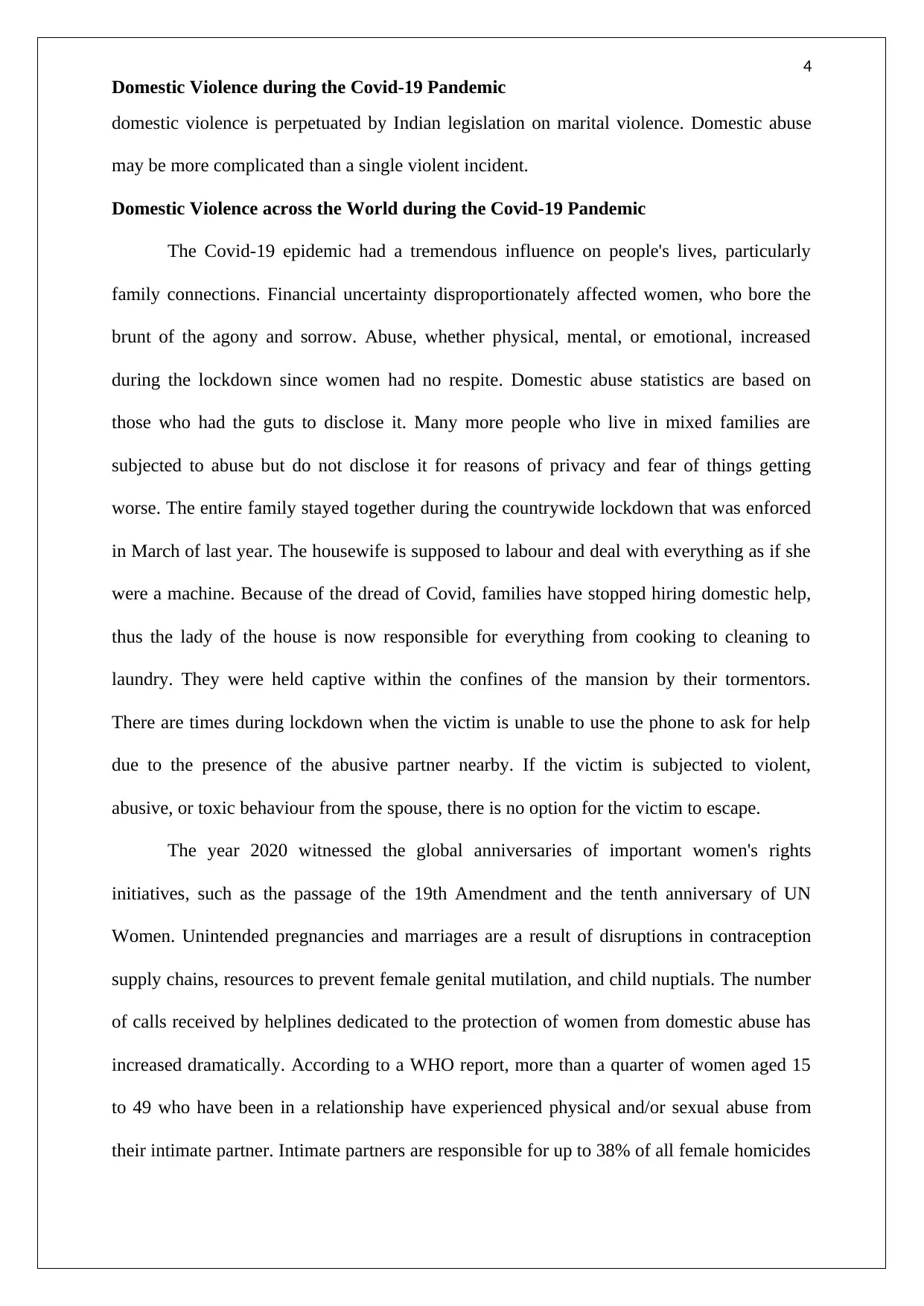
4
Domestic Violence during the Covid-19 Pandemic
domestic violence is perpetuated by Indian legislation on marital violence. Domestic abuse
may be more complicated than a single violent incident.
Domestic Violence across the World during the Covid-19 Pandemic
The Covid-19 epidemic had a tremendous influence on people's lives, particularly
family connections. Financial uncertainty disproportionately affected women, who bore the
brunt of the agony and sorrow. Abuse, whether physical, mental, or emotional, increased
during the lockdown since women had no respite. Domestic abuse statistics are based on
those who had the guts to disclose it. Many more people who live in mixed families are
subjected to abuse but do not disclose it for reasons of privacy and fear of things getting
worse. The entire family stayed together during the countrywide lockdown that was enforced
in March of last year. The housewife is supposed to labour and deal with everything as if she
were a machine. Because of the dread of Covid, families have stopped hiring domestic help,
thus the lady of the house is now responsible for everything from cooking to cleaning to
laundry. They were held captive within the confines of the mansion by their tormentors.
There are times during lockdown when the victim is unable to use the phone to ask for help
due to the presence of the abusive partner nearby. If the victim is subjected to violent,
abusive, or toxic behaviour from the spouse, there is no option for the victim to escape.
The year 2020 witnessed the global anniversaries of important women's rights
initiatives, such as the passage of the 19th Amendment and the tenth anniversary of UN
Women. Unintended pregnancies and marriages are a result of disruptions in contraception
supply chains, resources to prevent female genital mutilation, and child nuptials. The number
of calls received by helplines dedicated to the protection of women from domestic abuse has
increased dramatically. According to a WHO report, more than a quarter of women aged 15
to 49 who have been in a relationship have experienced physical and/or sexual abuse from
their intimate partner. Intimate partners are responsible for up to 38% of all female homicides
Domestic Violence during the Covid-19 Pandemic
domestic violence is perpetuated by Indian legislation on marital violence. Domestic abuse
may be more complicated than a single violent incident.
Domestic Violence across the World during the Covid-19 Pandemic
The Covid-19 epidemic had a tremendous influence on people's lives, particularly
family connections. Financial uncertainty disproportionately affected women, who bore the
brunt of the agony and sorrow. Abuse, whether physical, mental, or emotional, increased
during the lockdown since women had no respite. Domestic abuse statistics are based on
those who had the guts to disclose it. Many more people who live in mixed families are
subjected to abuse but do not disclose it for reasons of privacy and fear of things getting
worse. The entire family stayed together during the countrywide lockdown that was enforced
in March of last year. The housewife is supposed to labour and deal with everything as if she
were a machine. Because of the dread of Covid, families have stopped hiring domestic help,
thus the lady of the house is now responsible for everything from cooking to cleaning to
laundry. They were held captive within the confines of the mansion by their tormentors.
There are times during lockdown when the victim is unable to use the phone to ask for help
due to the presence of the abusive partner nearby. If the victim is subjected to violent,
abusive, or toxic behaviour from the spouse, there is no option for the victim to escape.
The year 2020 witnessed the global anniversaries of important women's rights
initiatives, such as the passage of the 19th Amendment and the tenth anniversary of UN
Women. Unintended pregnancies and marriages are a result of disruptions in contraception
supply chains, resources to prevent female genital mutilation, and child nuptials. The number
of calls received by helplines dedicated to the protection of women from domestic abuse has
increased dramatically. According to a WHO report, more than a quarter of women aged 15
to 49 who have been in a relationship have experienced physical and/or sexual abuse from
their intimate partner. Intimate partners are responsible for up to 38% of all female homicides
Paraphrase This Document
Need a fresh take? Get an instant paraphrase of this document with our AI Paraphraser
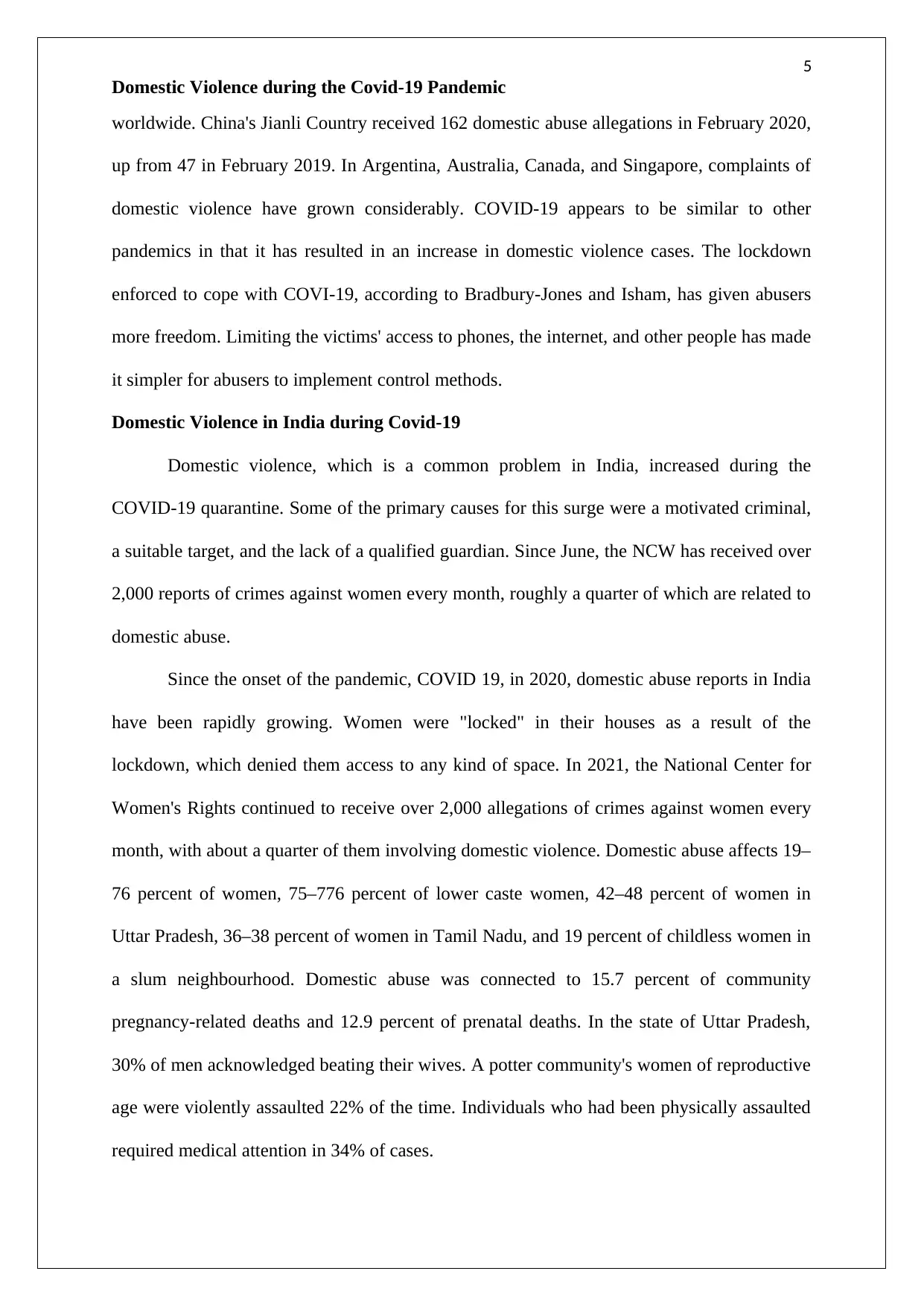
5
Domestic Violence during the Covid-19 Pandemic
worldwide. China's Jianli Country received 162 domestic abuse allegations in February 2020,
up from 47 in February 2019. In Argentina, Australia, Canada, and Singapore, complaints of
domestic violence have grown considerably. COVID-19 appears to be similar to other
pandemics in that it has resulted in an increase in domestic violence cases. The lockdown
enforced to cope with COVI-19, according to Bradbury-Jones and Isham, has given abusers
more freedom. Limiting the victims' access to phones, the internet, and other people has made
it simpler for abusers to implement control methods.
Domestic Violence in India during Covid-19
Domestic violence, which is a common problem in India, increased during the
COVID-19 quarantine. Some of the primary causes for this surge were a motivated criminal,
a suitable target, and the lack of a qualified guardian. Since June, the NCW has received over
2,000 reports of crimes against women every month, roughly a quarter of which are related to
domestic abuse.
Since the onset of the pandemic, COVID 19, in 2020, domestic abuse reports in India
have been rapidly growing. Women were "locked" in their houses as a result of the
lockdown, which denied them access to any kind of space. In 2021, the National Center for
Women's Rights continued to receive over 2,000 allegations of crimes against women every
month, with about a quarter of them involving domestic violence. Domestic abuse affects 19–
76 percent of women, 75–776 percent of lower caste women, 42–48 percent of women in
Uttar Pradesh, 36–38 percent of women in Tamil Nadu, and 19 percent of childless women in
a slum neighbourhood. Domestic abuse was connected to 15.7 percent of community
pregnancy-related deaths and 12.9 percent of prenatal deaths. In the state of Uttar Pradesh,
30% of men acknowledged beating their wives. A potter community's women of reproductive
age were violently assaulted 22% of the time. Individuals who had been physically assaulted
required medical attention in 34% of cases.
Domestic Violence during the Covid-19 Pandemic
worldwide. China's Jianli Country received 162 domestic abuse allegations in February 2020,
up from 47 in February 2019. In Argentina, Australia, Canada, and Singapore, complaints of
domestic violence have grown considerably. COVID-19 appears to be similar to other
pandemics in that it has resulted in an increase in domestic violence cases. The lockdown
enforced to cope with COVI-19, according to Bradbury-Jones and Isham, has given abusers
more freedom. Limiting the victims' access to phones, the internet, and other people has made
it simpler for abusers to implement control methods.
Domestic Violence in India during Covid-19
Domestic violence, which is a common problem in India, increased during the
COVID-19 quarantine. Some of the primary causes for this surge were a motivated criminal,
a suitable target, and the lack of a qualified guardian. Since June, the NCW has received over
2,000 reports of crimes against women every month, roughly a quarter of which are related to
domestic abuse.
Since the onset of the pandemic, COVID 19, in 2020, domestic abuse reports in India
have been rapidly growing. Women were "locked" in their houses as a result of the
lockdown, which denied them access to any kind of space. In 2021, the National Center for
Women's Rights continued to receive over 2,000 allegations of crimes against women every
month, with about a quarter of them involving domestic violence. Domestic abuse affects 19–
76 percent of women, 75–776 percent of lower caste women, 42–48 percent of women in
Uttar Pradesh, 36–38 percent of women in Tamil Nadu, and 19 percent of childless women in
a slum neighbourhood. Domestic abuse was connected to 15.7 percent of community
pregnancy-related deaths and 12.9 percent of prenatal deaths. In the state of Uttar Pradesh,
30% of men acknowledged beating their wives. A potter community's women of reproductive
age were violently assaulted 22% of the time. Individuals who had been physically assaulted
required medical attention in 34% of cases.
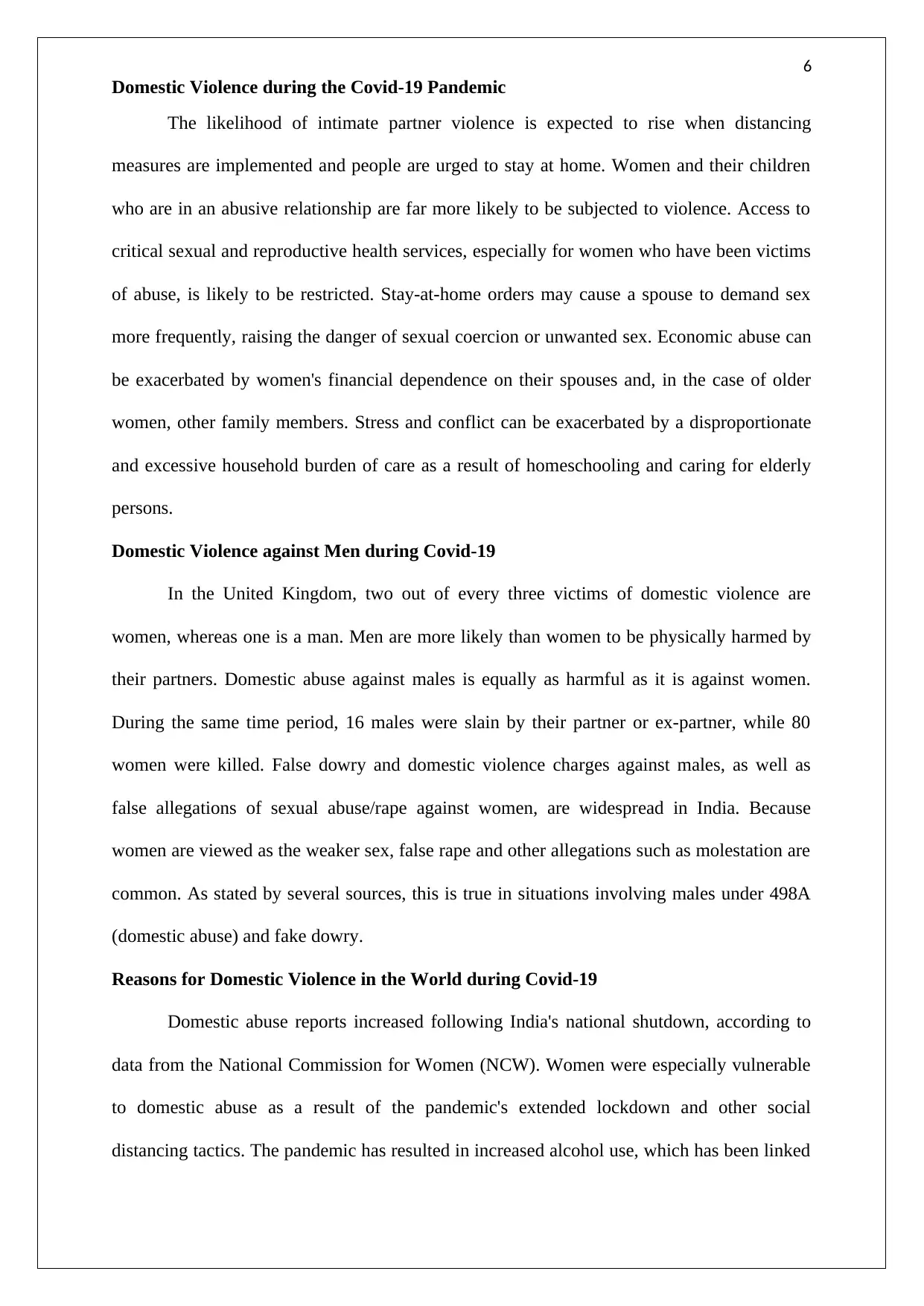
6
Domestic Violence during the Covid-19 Pandemic
The likelihood of intimate partner violence is expected to rise when distancing
measures are implemented and people are urged to stay at home. Women and their children
who are in an abusive relationship are far more likely to be subjected to violence. Access to
critical sexual and reproductive health services, especially for women who have been victims
of abuse, is likely to be restricted. Stay-at-home orders may cause a spouse to demand sex
more frequently, raising the danger of sexual coercion or unwanted sex. Economic abuse can
be exacerbated by women's financial dependence on their spouses and, in the case of older
women, other family members. Stress and conflict can be exacerbated by a disproportionate
and excessive household burden of care as a result of homeschooling and caring for elderly
persons.
Domestic Violence against Men during Covid-19
In the United Kingdom, two out of every three victims of domestic violence are
women, whereas one is a man. Men are more likely than women to be physically harmed by
their partners. Domestic abuse against males is equally as harmful as it is against women.
During the same time period, 16 males were slain by their partner or ex-partner, while 80
women were killed. False dowry and domestic violence charges against males, as well as
false allegations of sexual abuse/rape against women, are widespread in India. Because
women are viewed as the weaker sex, false rape and other allegations such as molestation are
common. As stated by several sources, this is true in situations involving males under 498A
(domestic abuse) and fake dowry.
Reasons for Domestic Violence in the World during Covid-19
Domestic abuse reports increased following India's national shutdown, according to
data from the National Commission for Women (NCW). Women were especially vulnerable
to domestic abuse as a result of the pandemic's extended lockdown and other social
distancing tactics. The pandemic has resulted in increased alcohol use, which has been linked
Domestic Violence during the Covid-19 Pandemic
The likelihood of intimate partner violence is expected to rise when distancing
measures are implemented and people are urged to stay at home. Women and their children
who are in an abusive relationship are far more likely to be subjected to violence. Access to
critical sexual and reproductive health services, especially for women who have been victims
of abuse, is likely to be restricted. Stay-at-home orders may cause a spouse to demand sex
more frequently, raising the danger of sexual coercion or unwanted sex. Economic abuse can
be exacerbated by women's financial dependence on their spouses and, in the case of older
women, other family members. Stress and conflict can be exacerbated by a disproportionate
and excessive household burden of care as a result of homeschooling and caring for elderly
persons.
Domestic Violence against Men during Covid-19
In the United Kingdom, two out of every three victims of domestic violence are
women, whereas one is a man. Men are more likely than women to be physically harmed by
their partners. Domestic abuse against males is equally as harmful as it is against women.
During the same time period, 16 males were slain by their partner or ex-partner, while 80
women were killed. False dowry and domestic violence charges against males, as well as
false allegations of sexual abuse/rape against women, are widespread in India. Because
women are viewed as the weaker sex, false rape and other allegations such as molestation are
common. As stated by several sources, this is true in situations involving males under 498A
(domestic abuse) and fake dowry.
Reasons for Domestic Violence in the World during Covid-19
Domestic abuse reports increased following India's national shutdown, according to
data from the National Commission for Women (NCW). Women were especially vulnerable
to domestic abuse as a result of the pandemic's extended lockdown and other social
distancing tactics. The pandemic has resulted in increased alcohol use, which has been linked
⊘ This is a preview!⊘
Do you want full access?
Subscribe today to unlock all pages.

Trusted by 1+ million students worldwide
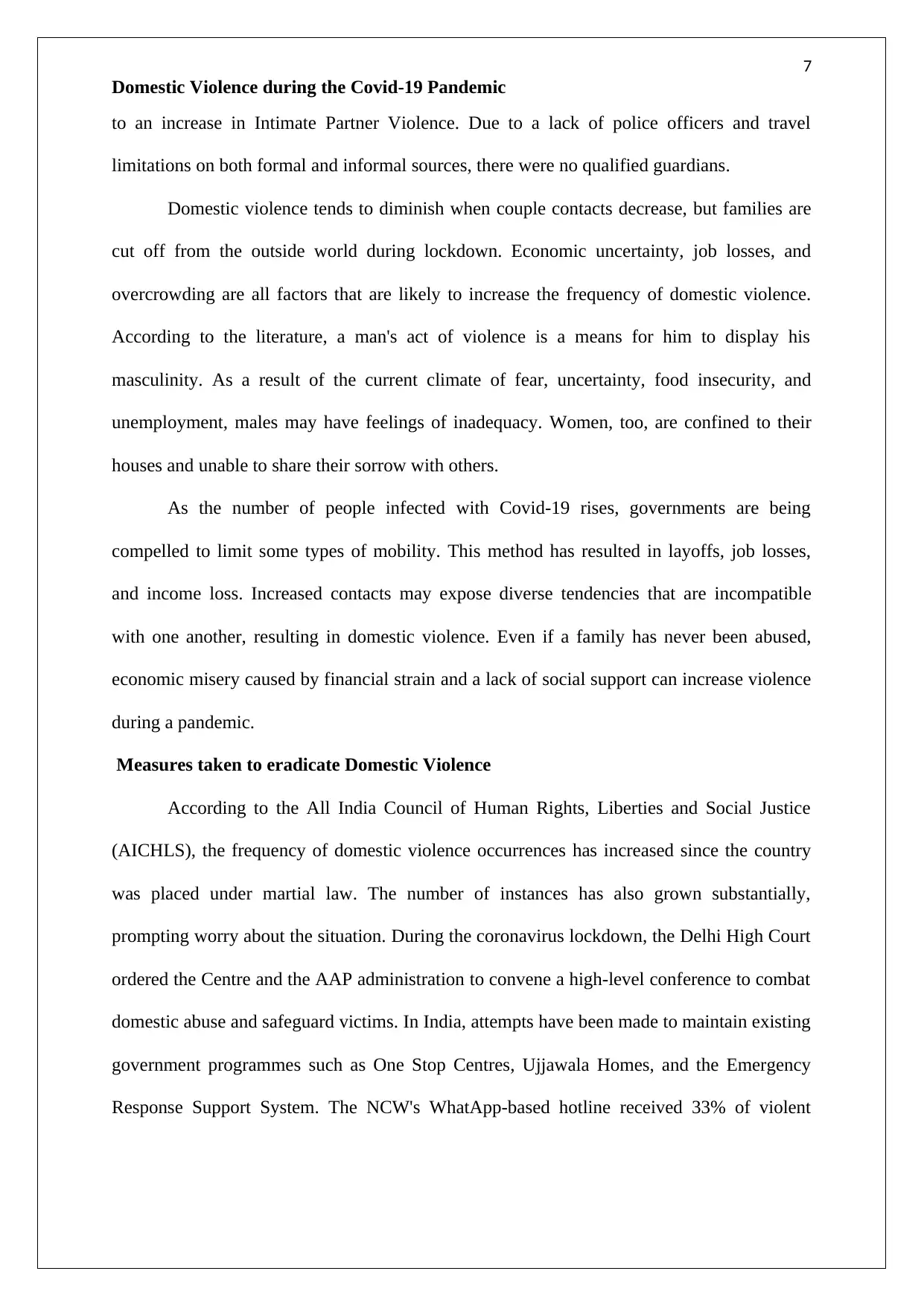
7
Domestic Violence during the Covid-19 Pandemic
to an increase in Intimate Partner Violence. Due to a lack of police officers and travel
limitations on both formal and informal sources, there were no qualified guardians.
Domestic violence tends to diminish when couple contacts decrease, but families are
cut off from the outside world during lockdown. Economic uncertainty, job losses, and
overcrowding are all factors that are likely to increase the frequency of domestic violence.
According to the literature, a man's act of violence is a means for him to display his
masculinity. As a result of the current climate of fear, uncertainty, food insecurity, and
unemployment, males may have feelings of inadequacy. Women, too, are confined to their
houses and unable to share their sorrow with others.
As the number of people infected with Covid-19 rises, governments are being
compelled to limit some types of mobility. This method has resulted in layoffs, job losses,
and income loss. Increased contacts may expose diverse tendencies that are incompatible
with one another, resulting in domestic violence. Even if a family has never been abused,
economic misery caused by financial strain and a lack of social support can increase violence
during a pandemic.
Measures taken to eradicate Domestic Violence
According to the All India Council of Human Rights, Liberties and Social Justice
(AICHLS), the frequency of domestic violence occurrences has increased since the country
was placed under martial law. The number of instances has also grown substantially,
prompting worry about the situation. During the coronavirus lockdown, the Delhi High Court
ordered the Centre and the AAP administration to convene a high-level conference to combat
domestic abuse and safeguard victims. In India, attempts have been made to maintain existing
government programmes such as One Stop Centres, Ujjawala Homes, and the Emergency
Response Support System. The NCW's WhatApp-based hotline received 33% of violent
Domestic Violence during the Covid-19 Pandemic
to an increase in Intimate Partner Violence. Due to a lack of police officers and travel
limitations on both formal and informal sources, there were no qualified guardians.
Domestic violence tends to diminish when couple contacts decrease, but families are
cut off from the outside world during lockdown. Economic uncertainty, job losses, and
overcrowding are all factors that are likely to increase the frequency of domestic violence.
According to the literature, a man's act of violence is a means for him to display his
masculinity. As a result of the current climate of fear, uncertainty, food insecurity, and
unemployment, males may have feelings of inadequacy. Women, too, are confined to their
houses and unable to share their sorrow with others.
As the number of people infected with Covid-19 rises, governments are being
compelled to limit some types of mobility. This method has resulted in layoffs, job losses,
and income loss. Increased contacts may expose diverse tendencies that are incompatible
with one another, resulting in domestic violence. Even if a family has never been abused,
economic misery caused by financial strain and a lack of social support can increase violence
during a pandemic.
Measures taken to eradicate Domestic Violence
According to the All India Council of Human Rights, Liberties and Social Justice
(AICHLS), the frequency of domestic violence occurrences has increased since the country
was placed under martial law. The number of instances has also grown substantially,
prompting worry about the situation. During the coronavirus lockdown, the Delhi High Court
ordered the Centre and the AAP administration to convene a high-level conference to combat
domestic abuse and safeguard victims. In India, attempts have been made to maintain existing
government programmes such as One Stop Centres, Ujjawala Homes, and the Emergency
Response Support System. The NCW's WhatApp-based hotline received 33% of violent
Paraphrase This Document
Need a fresh take? Get an instant paraphrase of this document with our AI Paraphraser
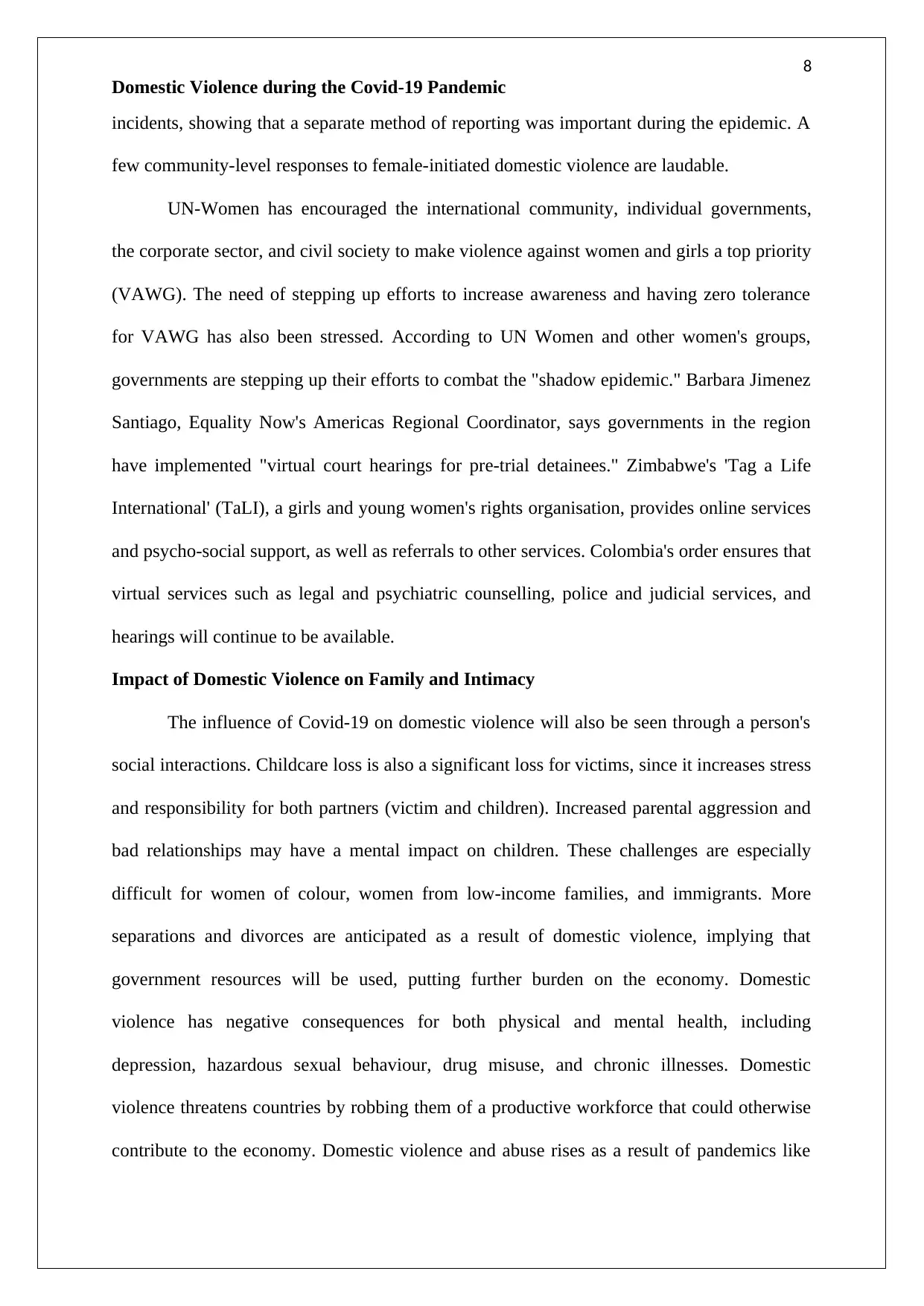
8
Domestic Violence during the Covid-19 Pandemic
incidents, showing that a separate method of reporting was important during the epidemic. A
few community-level responses to female-initiated domestic violence are laudable.
UN-Women has encouraged the international community, individual governments,
the corporate sector, and civil society to make violence against women and girls a top priority
(VAWG). The need of stepping up efforts to increase awareness and having zero tolerance
for VAWG has also been stressed. According to UN Women and other women's groups,
governments are stepping up their efforts to combat the "shadow epidemic." Barbara Jimenez
Santiago, Equality Now's Americas Regional Coordinator, says governments in the region
have implemented "virtual court hearings for pre-trial detainees." Zimbabwe's 'Tag a Life
International' (TaLI), a girls and young women's rights organisation, provides online services
and psycho-social support, as well as referrals to other services. Colombia's order ensures that
virtual services such as legal and psychiatric counselling, police and judicial services, and
hearings will continue to be available.
Impact of Domestic Violence on Family and Intimacy
The influence of Covid-19 on domestic violence will also be seen through a person's
social interactions. Childcare loss is also a significant loss for victims, since it increases stress
and responsibility for both partners (victim and children). Increased parental aggression and
bad relationships may have a mental impact on children. These challenges are especially
difficult for women of colour, women from low-income families, and immigrants. More
separations and divorces are anticipated as a result of domestic violence, implying that
government resources will be used, putting further burden on the economy. Domestic
violence has negative consequences for both physical and mental health, including
depression, hazardous sexual behaviour, drug misuse, and chronic illnesses. Domestic
violence threatens countries by robbing them of a productive workforce that could otherwise
contribute to the economy. Domestic violence and abuse rises as a result of pandemics like
Domestic Violence during the Covid-19 Pandemic
incidents, showing that a separate method of reporting was important during the epidemic. A
few community-level responses to female-initiated domestic violence are laudable.
UN-Women has encouraged the international community, individual governments,
the corporate sector, and civil society to make violence against women and girls a top priority
(VAWG). The need of stepping up efforts to increase awareness and having zero tolerance
for VAWG has also been stressed. According to UN Women and other women's groups,
governments are stepping up their efforts to combat the "shadow epidemic." Barbara Jimenez
Santiago, Equality Now's Americas Regional Coordinator, says governments in the region
have implemented "virtual court hearings for pre-trial detainees." Zimbabwe's 'Tag a Life
International' (TaLI), a girls and young women's rights organisation, provides online services
and psycho-social support, as well as referrals to other services. Colombia's order ensures that
virtual services such as legal and psychiatric counselling, police and judicial services, and
hearings will continue to be available.
Impact of Domestic Violence on Family and Intimacy
The influence of Covid-19 on domestic violence will also be seen through a person's
social interactions. Childcare loss is also a significant loss for victims, since it increases stress
and responsibility for both partners (victim and children). Increased parental aggression and
bad relationships may have a mental impact on children. These challenges are especially
difficult for women of colour, women from low-income families, and immigrants. More
separations and divorces are anticipated as a result of domestic violence, implying that
government resources will be used, putting further burden on the economy. Domestic
violence has negative consequences for both physical and mental health, including
depression, hazardous sexual behaviour, drug misuse, and chronic illnesses. Domestic
violence threatens countries by robbing them of a productive workforce that could otherwise
contribute to the economy. Domestic violence and abuse rises as a result of pandemics like
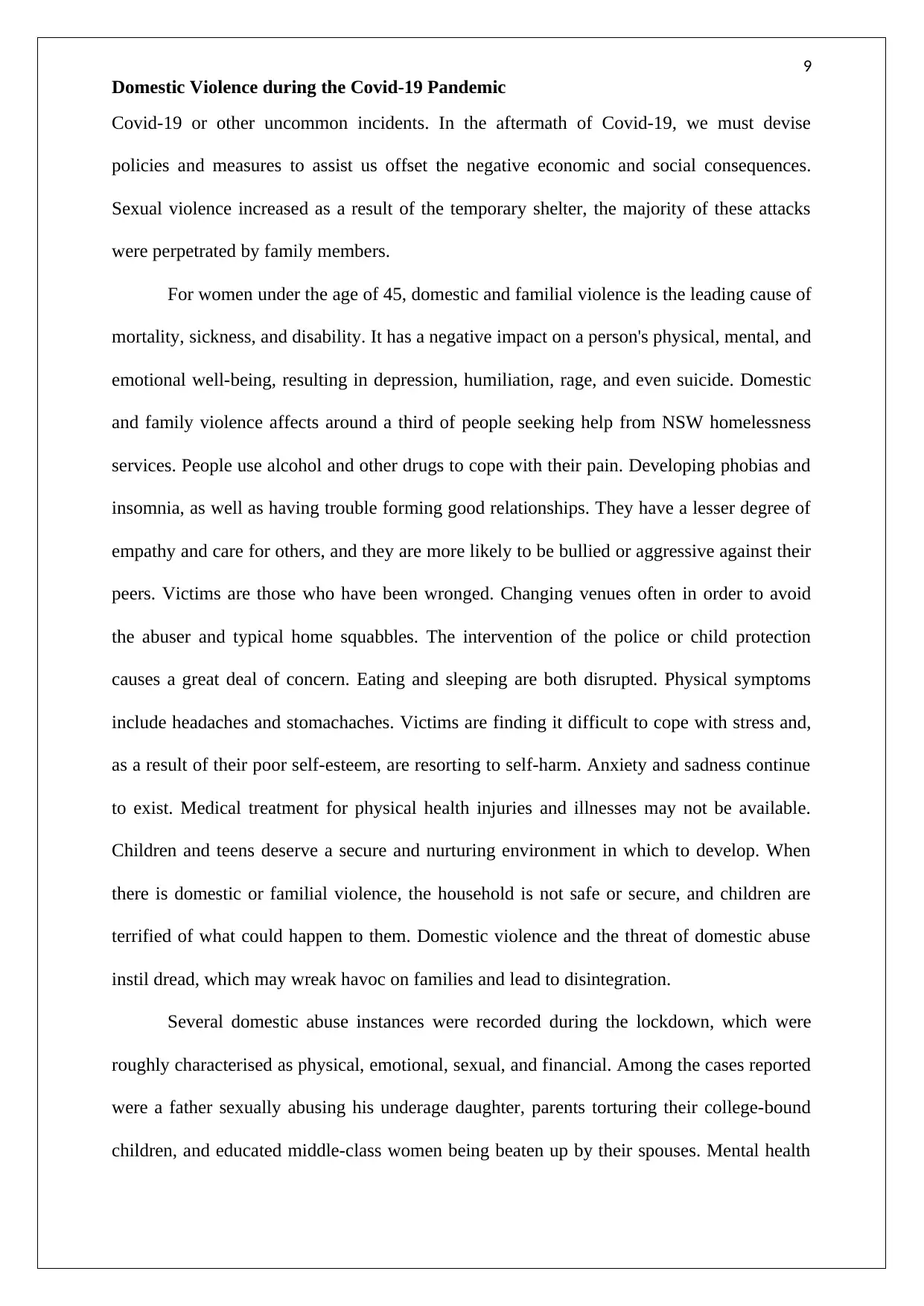
9
Domestic Violence during the Covid-19 Pandemic
Covid-19 or other uncommon incidents. In the aftermath of Covid-19, we must devise
policies and measures to assist us offset the negative economic and social consequences.
Sexual violence increased as a result of the temporary shelter, the majority of these attacks
were perpetrated by family members.
For women under the age of 45, domestic and familial violence is the leading cause of
mortality, sickness, and disability. It has a negative impact on a person's physical, mental, and
emotional well-being, resulting in depression, humiliation, rage, and even suicide. Domestic
and family violence affects around a third of people seeking help from NSW homelessness
services. People use alcohol and other drugs to cope with their pain. Developing phobias and
insomnia, as well as having trouble forming good relationships. They have a lesser degree of
empathy and care for others, and they are more likely to be bullied or aggressive against their
peers. Victims are those who have been wronged. Changing venues often in order to avoid
the abuser and typical home squabbles. The intervention of the police or child protection
causes a great deal of concern. Eating and sleeping are both disrupted. Physical symptoms
include headaches and stomachaches. Victims are finding it difficult to cope with stress and,
as a result of their poor self-esteem, are resorting to self-harm. Anxiety and sadness continue
to exist. Medical treatment for physical health injuries and illnesses may not be available.
Children and teens deserve a secure and nurturing environment in which to develop. When
there is domestic or familial violence, the household is not safe or secure, and children are
terrified of what could happen to them. Domestic violence and the threat of domestic abuse
instil dread, which may wreak havoc on families and lead to disintegration.
Several domestic abuse instances were recorded during the lockdown, which were
roughly characterised as physical, emotional, sexual, and financial. Among the cases reported
were a father sexually abusing his underage daughter, parents torturing their college-bound
children, and educated middle-class women being beaten up by their spouses. Mental health
Domestic Violence during the Covid-19 Pandemic
Covid-19 or other uncommon incidents. In the aftermath of Covid-19, we must devise
policies and measures to assist us offset the negative economic and social consequences.
Sexual violence increased as a result of the temporary shelter, the majority of these attacks
were perpetrated by family members.
For women under the age of 45, domestic and familial violence is the leading cause of
mortality, sickness, and disability. It has a negative impact on a person's physical, mental, and
emotional well-being, resulting in depression, humiliation, rage, and even suicide. Domestic
and family violence affects around a third of people seeking help from NSW homelessness
services. People use alcohol and other drugs to cope with their pain. Developing phobias and
insomnia, as well as having trouble forming good relationships. They have a lesser degree of
empathy and care for others, and they are more likely to be bullied or aggressive against their
peers. Victims are those who have been wronged. Changing venues often in order to avoid
the abuser and typical home squabbles. The intervention of the police or child protection
causes a great deal of concern. Eating and sleeping are both disrupted. Physical symptoms
include headaches and stomachaches. Victims are finding it difficult to cope with stress and,
as a result of their poor self-esteem, are resorting to self-harm. Anxiety and sadness continue
to exist. Medical treatment for physical health injuries and illnesses may not be available.
Children and teens deserve a secure and nurturing environment in which to develop. When
there is domestic or familial violence, the household is not safe or secure, and children are
terrified of what could happen to them. Domestic violence and the threat of domestic abuse
instil dread, which may wreak havoc on families and lead to disintegration.
Several domestic abuse instances were recorded during the lockdown, which were
roughly characterised as physical, emotional, sexual, and financial. Among the cases reported
were a father sexually abusing his underage daughter, parents torturing their college-bound
children, and educated middle-class women being beaten up by their spouses. Mental health
⊘ This is a preview!⊘
Do you want full access?
Subscribe today to unlock all pages.

Trusted by 1+ million students worldwide
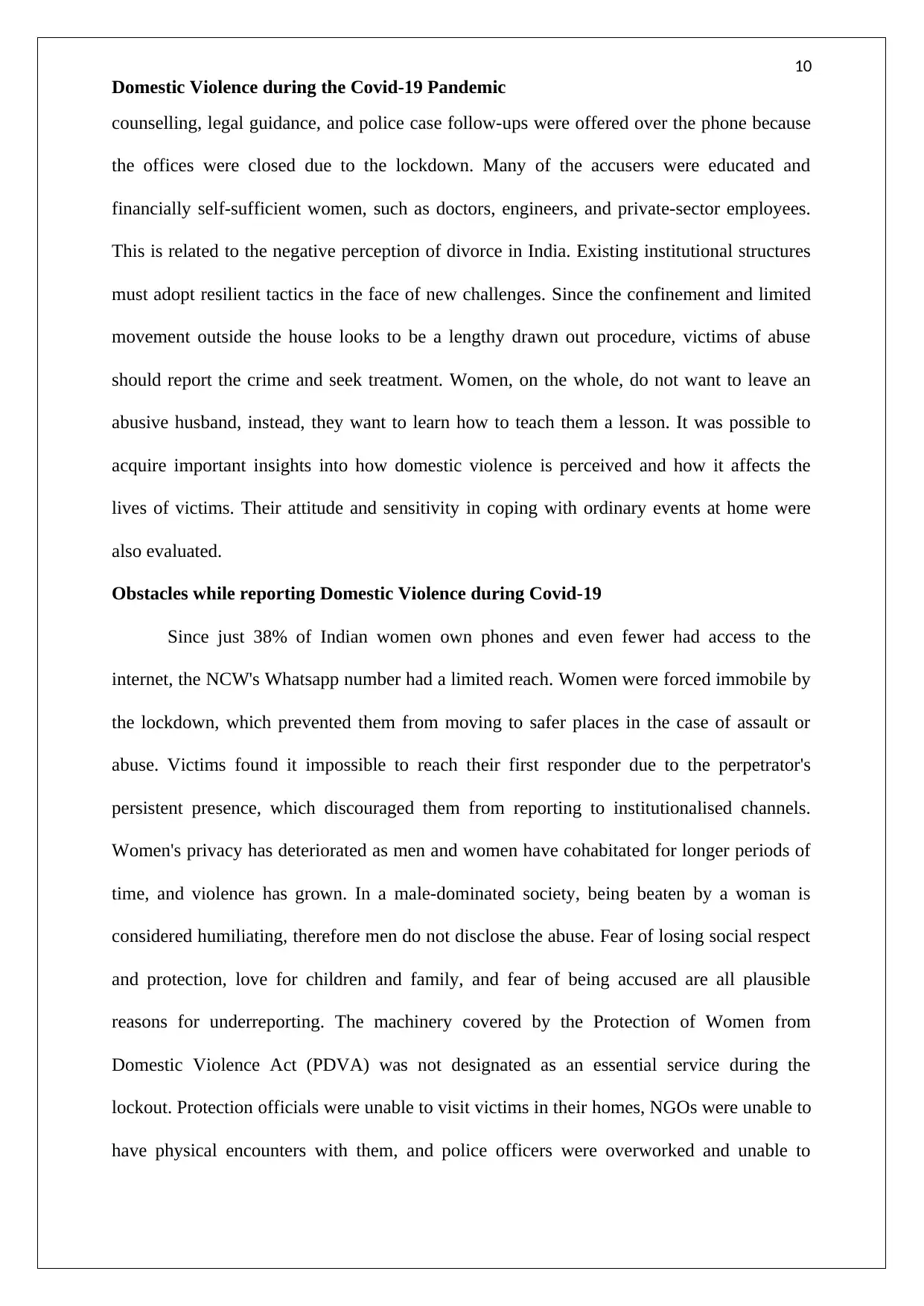
10
Domestic Violence during the Covid-19 Pandemic
counselling, legal guidance, and police case follow-ups were offered over the phone because
the offices were closed due to the lockdown. Many of the accusers were educated and
financially self-sufficient women, such as doctors, engineers, and private-sector employees.
This is related to the negative perception of divorce in India. Existing institutional structures
must adopt resilient tactics in the face of new challenges. Since the confinement and limited
movement outside the house looks to be a lengthy drawn out procedure, victims of abuse
should report the crime and seek treatment. Women, on the whole, do not want to leave an
abusive husband, instead, they want to learn how to teach them a lesson. It was possible to
acquire important insights into how domestic violence is perceived and how it affects the
lives of victims. Their attitude and sensitivity in coping with ordinary events at home were
also evaluated.
Obstacles while reporting Domestic Violence during Covid-19
Since just 38% of Indian women own phones and even fewer had access to the
internet, the NCW's Whatsapp number had a limited reach. Women were forced immobile by
the lockdown, which prevented them from moving to safer places in the case of assault or
abuse. Victims found it impossible to reach their first responder due to the perpetrator's
persistent presence, which discouraged them from reporting to institutionalised channels.
Women's privacy has deteriorated as men and women have cohabitated for longer periods of
time, and violence has grown. In a male-dominated society, being beaten by a woman is
considered humiliating, therefore men do not disclose the abuse. Fear of losing social respect
and protection, love for children and family, and fear of being accused are all plausible
reasons for underreporting. The machinery covered by the Protection of Women from
Domestic Violence Act (PDVA) was not designated as an essential service during the
lockout. Protection officials were unable to visit victims in their homes, NGOs were unable to
have physical encounters with them, and police officers were overworked and unable to
Domestic Violence during the Covid-19 Pandemic
counselling, legal guidance, and police case follow-ups were offered over the phone because
the offices were closed due to the lockdown. Many of the accusers were educated and
financially self-sufficient women, such as doctors, engineers, and private-sector employees.
This is related to the negative perception of divorce in India. Existing institutional structures
must adopt resilient tactics in the face of new challenges. Since the confinement and limited
movement outside the house looks to be a lengthy drawn out procedure, victims of abuse
should report the crime and seek treatment. Women, on the whole, do not want to leave an
abusive husband, instead, they want to learn how to teach them a lesson. It was possible to
acquire important insights into how domestic violence is perceived and how it affects the
lives of victims. Their attitude and sensitivity in coping with ordinary events at home were
also evaluated.
Obstacles while reporting Domestic Violence during Covid-19
Since just 38% of Indian women own phones and even fewer had access to the
internet, the NCW's Whatsapp number had a limited reach. Women were forced immobile by
the lockdown, which prevented them from moving to safer places in the case of assault or
abuse. Victims found it impossible to reach their first responder due to the perpetrator's
persistent presence, which discouraged them from reporting to institutionalised channels.
Women's privacy has deteriorated as men and women have cohabitated for longer periods of
time, and violence has grown. In a male-dominated society, being beaten by a woman is
considered humiliating, therefore men do not disclose the abuse. Fear of losing social respect
and protection, love for children and family, and fear of being accused are all plausible
reasons for underreporting. The machinery covered by the Protection of Women from
Domestic Violence Act (PDVA) was not designated as an essential service during the
lockout. Protection officials were unable to visit victims in their homes, NGOs were unable to
have physical encounters with them, and police officers were overworked and unable to
Paraphrase This Document
Need a fresh take? Get an instant paraphrase of this document with our AI Paraphraser
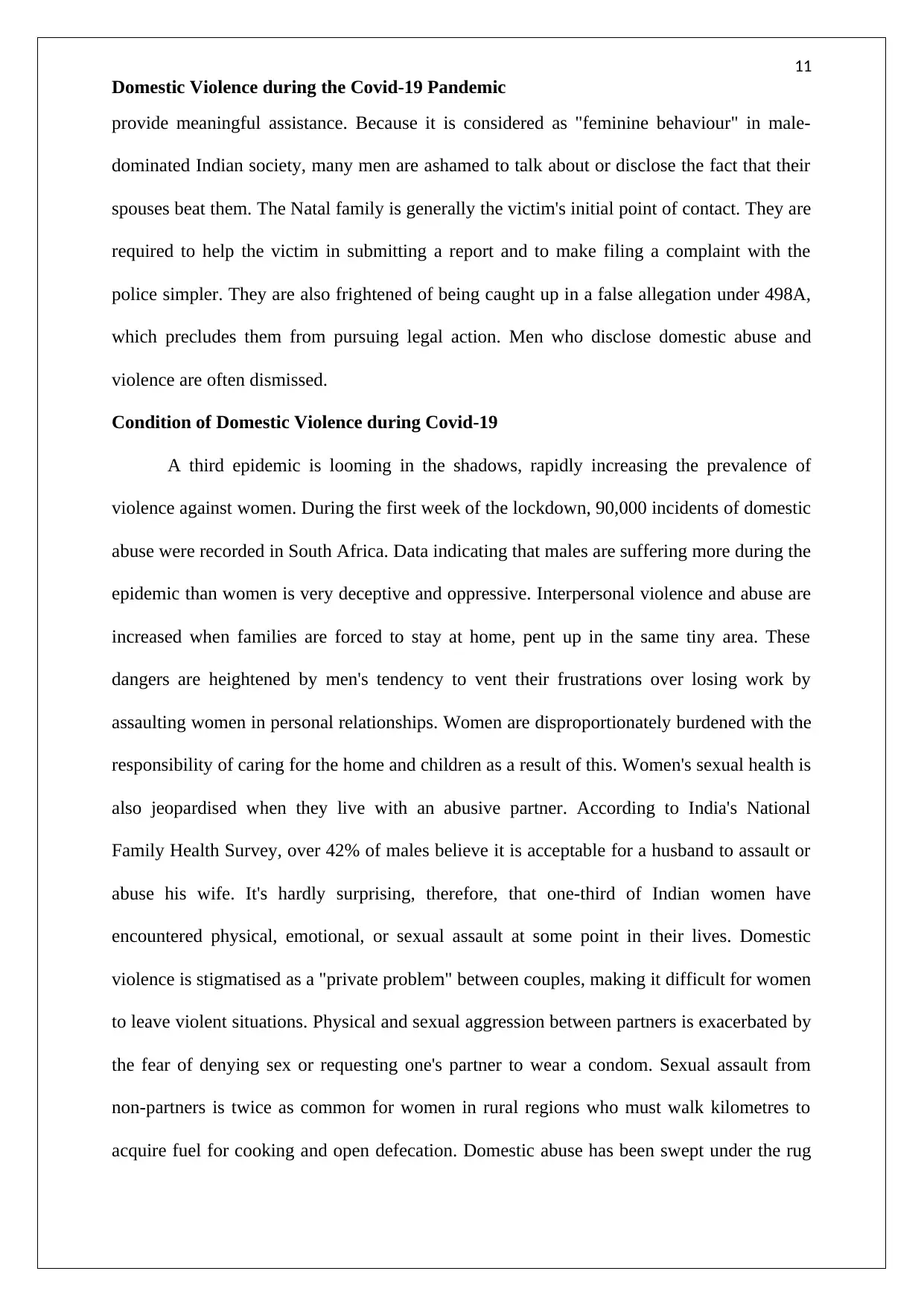
11
Domestic Violence during the Covid-19 Pandemic
provide meaningful assistance. Because it is considered as "feminine behaviour" in male-
dominated Indian society, many men are ashamed to talk about or disclose the fact that their
spouses beat them. The Natal family is generally the victim's initial point of contact. They are
required to help the victim in submitting a report and to make filing a complaint with the
police simpler. They are also frightened of being caught up in a false allegation under 498A,
which precludes them from pursuing legal action. Men who disclose domestic abuse and
violence are often dismissed.
Condition of Domestic Violence during Covid-19
A third epidemic is looming in the shadows, rapidly increasing the prevalence of
violence against women. During the first week of the lockdown, 90,000 incidents of domestic
abuse were recorded in South Africa. Data indicating that males are suffering more during the
epidemic than women is very deceptive and oppressive. Interpersonal violence and abuse are
increased when families are forced to stay at home, pent up in the same tiny area. These
dangers are heightened by men's tendency to vent their frustrations over losing work by
assaulting women in personal relationships. Women are disproportionately burdened with the
responsibility of caring for the home and children as a result of this. Women's sexual health is
also jeopardised when they live with an abusive partner. According to India's National
Family Health Survey, over 42% of males believe it is acceptable for a husband to assault or
abuse his wife. It's hardly surprising, therefore, that one-third of Indian women have
encountered physical, emotional, or sexual assault at some point in their lives. Domestic
violence is stigmatised as a "private problem" between couples, making it difficult for women
to leave violent situations. Physical and sexual aggression between partners is exacerbated by
the fear of denying sex or requesting one's partner to wear a condom. Sexual assault from
non-partners is twice as common for women in rural regions who must walk kilometres to
acquire fuel for cooking and open defecation. Domestic abuse has been swept under the rug
Domestic Violence during the Covid-19 Pandemic
provide meaningful assistance. Because it is considered as "feminine behaviour" in male-
dominated Indian society, many men are ashamed to talk about or disclose the fact that their
spouses beat them. The Natal family is generally the victim's initial point of contact. They are
required to help the victim in submitting a report and to make filing a complaint with the
police simpler. They are also frightened of being caught up in a false allegation under 498A,
which precludes them from pursuing legal action. Men who disclose domestic abuse and
violence are often dismissed.
Condition of Domestic Violence during Covid-19
A third epidemic is looming in the shadows, rapidly increasing the prevalence of
violence against women. During the first week of the lockdown, 90,000 incidents of domestic
abuse were recorded in South Africa. Data indicating that males are suffering more during the
epidemic than women is very deceptive and oppressive. Interpersonal violence and abuse are
increased when families are forced to stay at home, pent up in the same tiny area. These
dangers are heightened by men's tendency to vent their frustrations over losing work by
assaulting women in personal relationships. Women are disproportionately burdened with the
responsibility of caring for the home and children as a result of this. Women's sexual health is
also jeopardised when they live with an abusive partner. According to India's National
Family Health Survey, over 42% of males believe it is acceptable for a husband to assault or
abuse his wife. It's hardly surprising, therefore, that one-third of Indian women have
encountered physical, emotional, or sexual assault at some point in their lives. Domestic
violence is stigmatised as a "private problem" between couples, making it difficult for women
to leave violent situations. Physical and sexual aggression between partners is exacerbated by
the fear of denying sex or requesting one's partner to wear a condom. Sexual assault from
non-partners is twice as common for women in rural regions who must walk kilometres to
acquire fuel for cooking and open defecation. Domestic abuse has been swept under the rug
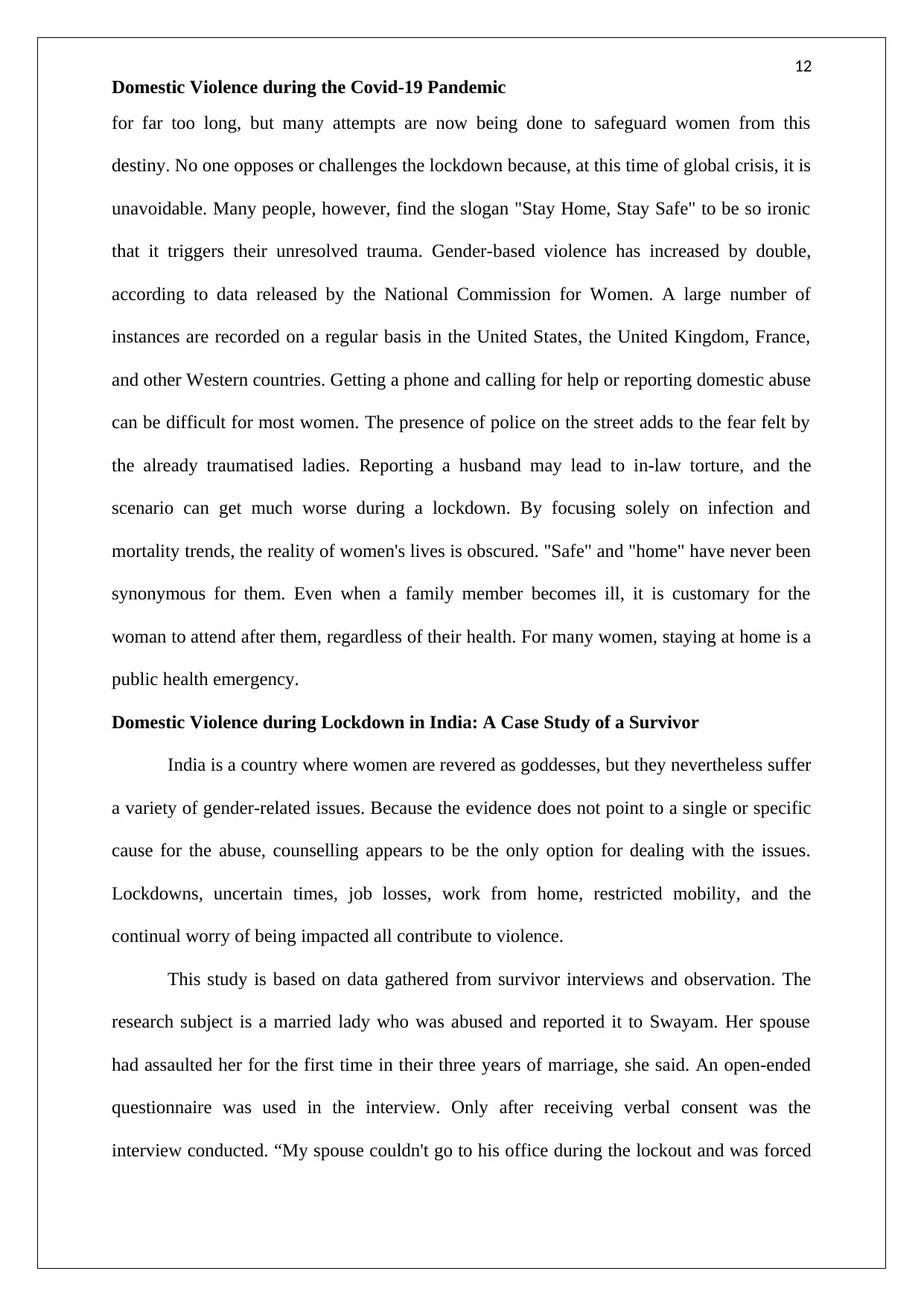
12
Domestic Violence during the Covid-19 Pandemic
for far too long, but many attempts are now being done to safeguard women from this
destiny. No one opposes or challenges the lockdown because, at this time of global crisis, it is
unavoidable. Many people, however, find the slogan "Stay Home, Stay Safe" to be so ironic
that it triggers their unresolved trauma. Gender-based violence has increased by double,
according to data released by the National Commission for Women. A large number of
instances are recorded on a regular basis in the United States, the United Kingdom, France,
and other Western countries. Getting a phone and calling for help or reporting domestic abuse
can be difficult for most women. The presence of police on the street adds to the fear felt by
the already traumatised ladies. Reporting a husband may lead to in-law torture, and the
scenario can get much worse during a lockdown. By focusing solely on infection and
mortality trends, the reality of women's lives is obscured. "Safe" and "home" have never been
synonymous for them. Even when a family member becomes ill, it is customary for the
woman to attend after them, regardless of their health. For many women, staying at home is a
public health emergency.
Domestic Violence during Lockdown in India: A Case Study of a Survivor
India is a country where women are revered as goddesses, but they nevertheless suffer
a variety of gender-related issues. Because the evidence does not point to a single or specific
cause for the abuse, counselling appears to be the only option for dealing with the issues.
Lockdowns, uncertain times, job losses, work from home, restricted mobility, and the
continual worry of being impacted all contribute to violence.
This study is based on data gathered from survivor interviews and observation. The
research subject is a married lady who was abused and reported it to Swayam. Her spouse
had assaulted her for the first time in their three years of marriage, she said. An open-ended
questionnaire was used in the interview. Only after receiving verbal consent was the
interview conducted. “My spouse couldn't go to his office during the lockout and was forced
Domestic Violence during the Covid-19 Pandemic
for far too long, but many attempts are now being done to safeguard women from this
destiny. No one opposes or challenges the lockdown because, at this time of global crisis, it is
unavoidable. Many people, however, find the slogan "Stay Home, Stay Safe" to be so ironic
that it triggers their unresolved trauma. Gender-based violence has increased by double,
according to data released by the National Commission for Women. A large number of
instances are recorded on a regular basis in the United States, the United Kingdom, France,
and other Western countries. Getting a phone and calling for help or reporting domestic abuse
can be difficult for most women. The presence of police on the street adds to the fear felt by
the already traumatised ladies. Reporting a husband may lead to in-law torture, and the
scenario can get much worse during a lockdown. By focusing solely on infection and
mortality trends, the reality of women's lives is obscured. "Safe" and "home" have never been
synonymous for them. Even when a family member becomes ill, it is customary for the
woman to attend after them, regardless of their health. For many women, staying at home is a
public health emergency.
Domestic Violence during Lockdown in India: A Case Study of a Survivor
India is a country where women are revered as goddesses, but they nevertheless suffer
a variety of gender-related issues. Because the evidence does not point to a single or specific
cause for the abuse, counselling appears to be the only option for dealing with the issues.
Lockdowns, uncertain times, job losses, work from home, restricted mobility, and the
continual worry of being impacted all contribute to violence.
This study is based on data gathered from survivor interviews and observation. The
research subject is a married lady who was abused and reported it to Swayam. Her spouse
had assaulted her for the first time in their three years of marriage, she said. An open-ended
questionnaire was used in the interview. Only after receiving verbal consent was the
interview conducted. “My spouse couldn't go to his office during the lockout and was forced
⊘ This is a preview!⊘
Do you want full access?
Subscribe today to unlock all pages.

Trusted by 1+ million students worldwide
1 out of 19
Related Documents
Your All-in-One AI-Powered Toolkit for Academic Success.
+13062052269
info@desklib.com
Available 24*7 on WhatsApp / Email
![[object Object]](/_next/static/media/star-bottom.7253800d.svg)
Unlock your academic potential
Copyright © 2020–2025 A2Z Services. All Rights Reserved. Developed and managed by ZUCOL.





